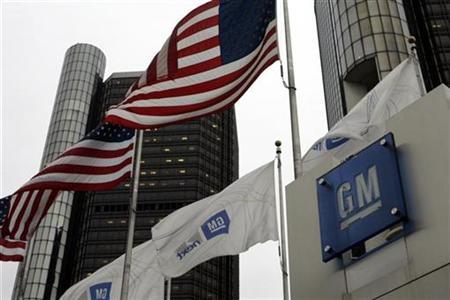Feb. 10 (Bloomberg) — General Motors Corp., the largest U.S. automaker, will cut 10,000 salaried jobs globally and reduce pay by as much as 10 percent to slash costs and prove its viability to keep $13.4 billion in government loans.
About 3,400 of GM’s 29,500 U.S. salaried workers will be dismissed by May 1, the Detroit-based automaker said in a statement. U.S. salaries will be cut temporarily by 10 percent for executives and by 3 percent to 7 percent for most others. GM Chief Executive Rick Wagoner, who already sliced his annual salary to $1, is reviewing salaries and benefits abroad.
“This is a dramatic step — it shows they are turning a corner” in their restructuring plan, said Gary Chaison, a labor relations professor at Clark University in Worcester, Massachusetts. “It gives GM tremendous leverage in talking to bondholders and the unions about their own cuts.”
GM must submit to the Treasury Department by Feb. 17 a plan to reorganize, restore profit and repay U.S. loans by the end of 2011. Advisers to GM, the United Auto Workers and bondholders are in meetings this week in Detroit to negotiate agreements that cut unsecured debt by two-thirds and win concessions on labor costs, people familiar with the talks said.
GM fell 5 cents, or 1.8 percent, to $2.78 at 2:07 p.m. in New York Stock Exchange composite trading. A year ago, the stock traded for $25.80. GM’s 8.375 percent note due in July 2033 gained 0.687 cent to 14.5 cents on the dollar, yielding 57.5 percent, according to Trace, the bond-pricing service of the Financial Industry Regulatory Authority.
Less Technology Spending
Today’s job and salary cuts are “the kind of things that we need to do to get this viability plan in shape and respond to this tough market condition,” Wagoner told reporters after meeting with Senator Jay Rockefeller, the West Virginia Democrat who chairs the Senate Commerce, Science and Transportation Committee.
Wagoner also planned to meet today with House Energy and Commerce Chairman Henry Waxman, a California Democrat, and Representative Edward Markey, a Massachusetts Democrat and chairman of the Select Committee on Energy Independence and Global Warming, according to a person familiar with the matter.
He said GM still intends requirements in the 2007 energy bill that automakers’ fleets must average at least 35 miles per gallon of gasoline by 2020.
“We’re committed to make the standards, and our plans enable us to do it,” Wagoner said. “But it’s a fairly significant amount of the product portfolio spending that we have over the next few years”
Cutting Labor Costs
Chrysler LLC and GM, awaiting President Barack Obama’s appointment of a so-called car czar to oversee their restructuring, need to win agreements from the union to cut retiree and other costs and from lenders to exchange debt for equity by next week’s deadline.
GM started offering buyouts to 62,000 union workers last week and is in talks with the UAW about trimming benefits. People familiar with those buyouts said the automaker is targeting more than 10,000 union jobs and is expecting more than half that number to accept.
“People are being let go in the worst times, in the worst possible towns. It’s sad,” Chaison said. “We’ve almost become accustomed to companies cutting 10,000, 15,000 jobs.”
Last month, GM forecast U.S. industrywide sales this year of 10.5 million cars and light trucks, compared with 13.2 million last year and an average of 16 million this decade. GM said it expects global sales will fall to 57.5 million autos this year from 67.1 million last year, or about 10 percent worse than a December forecast for global sales.
Accelerating Moves
GM said in a Dec. 2 report to Congress that it plans to reduce its total U.S. workforce in 2012 to 65,000 to 75,000 from 96,537 last year. Since then, the automaker has said the deteriorating economy is forcing it to look for more savings.
GM is shifting resources to areas that are “critical for our success,” spokesman Tom Wilkinson said. He wouldn’t say which divisions would lose the most workers.
“You keep the organization going, but you have a high price in the function of the departments,” said David Lipsky, an industrial-relations professor at Cornell University in Ithaca, New York. “And if you ever do turn the corner, you have to try to rebuild on a human-capital infrastructure that’s as weak as it can be.”
The automaker, which has lost $72.4 billion since 2004, reduced salaried-worker costs by 30 percent last year. The company has 73,000 salaried employees, who get fixed pay rather than an hourly rate. The so-called white-collar employees serve as engineers, accountants and designers.
‘Gives Them Leverage’
“These cuts help take away the argument that they haven’t done enough themselves,” Clark University’s Chaison said. “This also gives them leverage with the public perception.”
UAW President Ron Gettelfinger has said he is willing to make concessions if other stakeholders, including bondholders and auto executives, also make sacrifices.
GM is also cutting 219 UAW jobs in powertrain operations as part of an announcement Jan. 26 that it would end shifts at a Lansing, Michigan, sport-utility vehicle factory and a Lordstown, Ohio, car plant and temporarily idle operations at 13 other facilities because of slowing sales.
The automaker eliminated a line employing 150 workers making 3.6-liter engines at a plant in Flint, Michigan, and also will eliminate 69 jobs at a Warren, Michigan, transmission plant, spokeswoman Sharon Basel said today. GM is using temporary layoffs at other powertrain plants to keep production in line with the lower output at the factories, she said.
To contact the reporter on this story: Jeff Green in Southfield, Michigan, at [email protected]
Last Updated: February 10, 2009 15:10 EST
By Jeff Green
Source: Bloomberg
